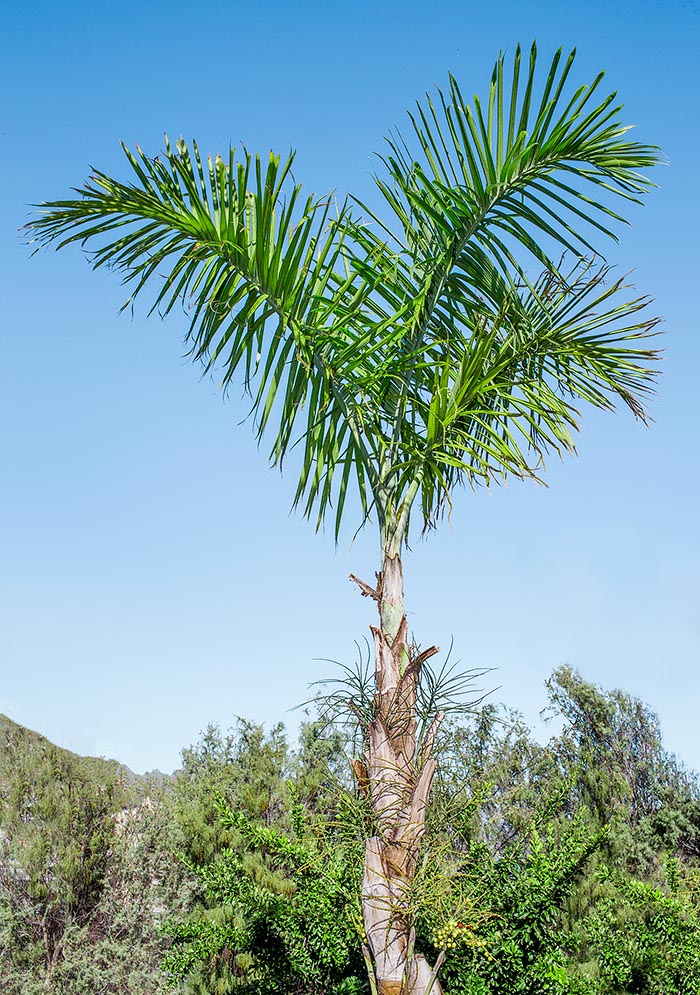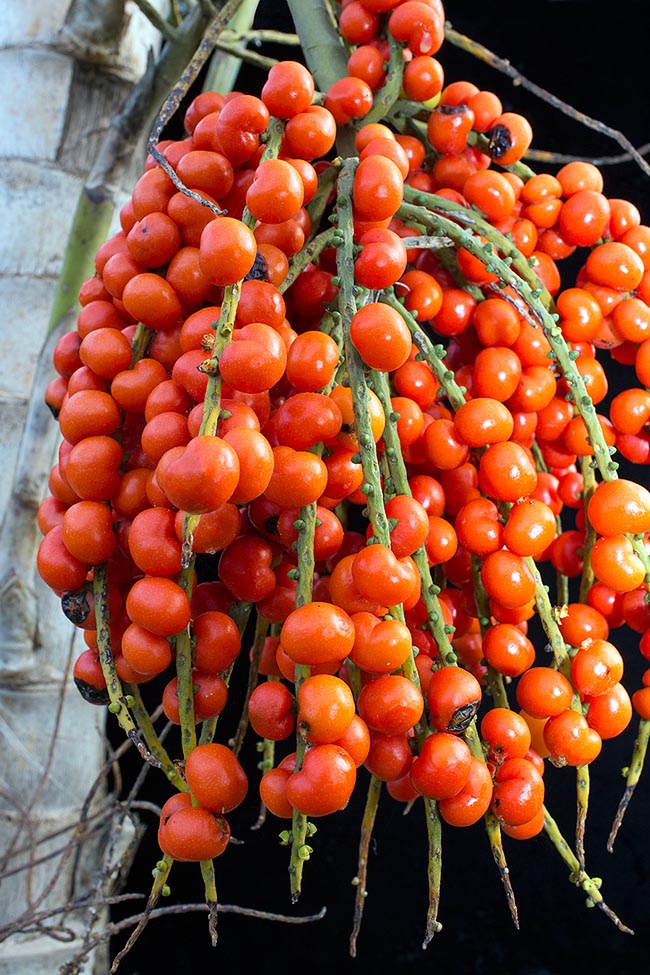Family : Arecaceae

Text © Pietro Puccio

English translation by Mario Beltramini

Native to Belize, Guatemala and Mexico, the Gaussia maya reaches the 20 m of height on a stem of 10-12 cm of diameter. Characteristic the simultaneous presence of numerous inflorescences along the stem in various stages of maturation © Giuseppe Mazza
The species is native to Belize, Guatemala and Mexico (Quintana Roo) where it grows in the forests on rocky calcareous soils at low altitudes.
The genus is honoured to the German mathematician Johann Friedrich Carl Gauss (1777-1855): the specific name refers to the first specimens found close to ruins of Mayan temples.
Common names: Maya palm (English); cambo, k’ambó, palmasito (Belize); gausia cimarrona, palma cambo, palma cimarrona (Mexico).
The Gaussia maya (O.F.Cook) H.J.Quero & Read (1986) is a solitary monoecious species, unarmed, with up to 20 m tall stem and 10-20 cm of diameter, slightly enlarged at the base, on which are visible and prominent the rings trace of the junction of the fallen leaves spaced of 8-15 cm.
The crown is formed by 5-8 leaves, on a 50-60 cm long petiole, pinnate, 2-3 m long, with 80-90 linear-lanceolate with acuminate apex leaflets per side, regularly inserted on the rachis, but arranged on 4 different planes, 60-70 cm long and 4 cm broad in the central part.
The foliar base, 60-70 cm long, open on the opposite side of the petiole, wraps entirely the stem for a length of about 30 cm.
Inflorescences initially among the leaves, then under, 70-80 cm long, enclosed by 4 pedunclar bracts of progressively increasing length, with ramifications of first or second order, bearing on each rachilla groups (acervuli) of 3 tiny uni-sexual sessile flowers, almost lined and closely matched, with one female flower at the base followed by the male ones. The male flowers open and fall in sequence starting from the extreme, when those of the group have fallen the female flower opens, this favours the crossed fecundation.

The globose or bilobate fruits of 1-1,5 cm of diameter, bright red when ripe, have a pulp irritating to the skin © Giuseppe Mazza
A characteristic of the species is the simultaneous presence of numerous inflorescences along the stem in different stages of maturation.
Globose or bilobate fruits, of 1-1,5 cm of diameter, initially of yellowish green colour, then bright red when ripe, containing seeds of irregular shape of about 1 cm of diameter; the pulp, fleshy, is irritating to the skin.
It reproduces by seed in calcareous draining loam maintained humid at the temperature of 26-28 °C, with germination times starting from about one month.
Little diffused species with on the average fast growth, suitable to tropical and humid subtropical climates and marginally to the milder warm temperate ones, where it can stand temperatures up to -2 °C for a very short period.
It requires high luminosity, even direct sun, but in the juvenile phase when it needs partial shade. It adapts to various types of soil, even if poor, provided draining, maintained almost constantly humid, even if when adult it can bear short dry periods, but grows better in the alkaline ones rich of organic substance.
Young specimens are particularly decorative in pot due to the bulbous base that in the adult plants tends to disappear.
There are not known particular utilizations by the local populations, excepting the stems, long lasting, at times employed in the rural buildings.
Because of the fragmentation of the population and the anthropic pressure the species has been inserted in the red list of the IUCN (International Union for the Conservation of Nature) as “vulnerable” (species under risk of extinction in nature).
Synonyms: Opsiandra maya O.F.Cook (1922).
